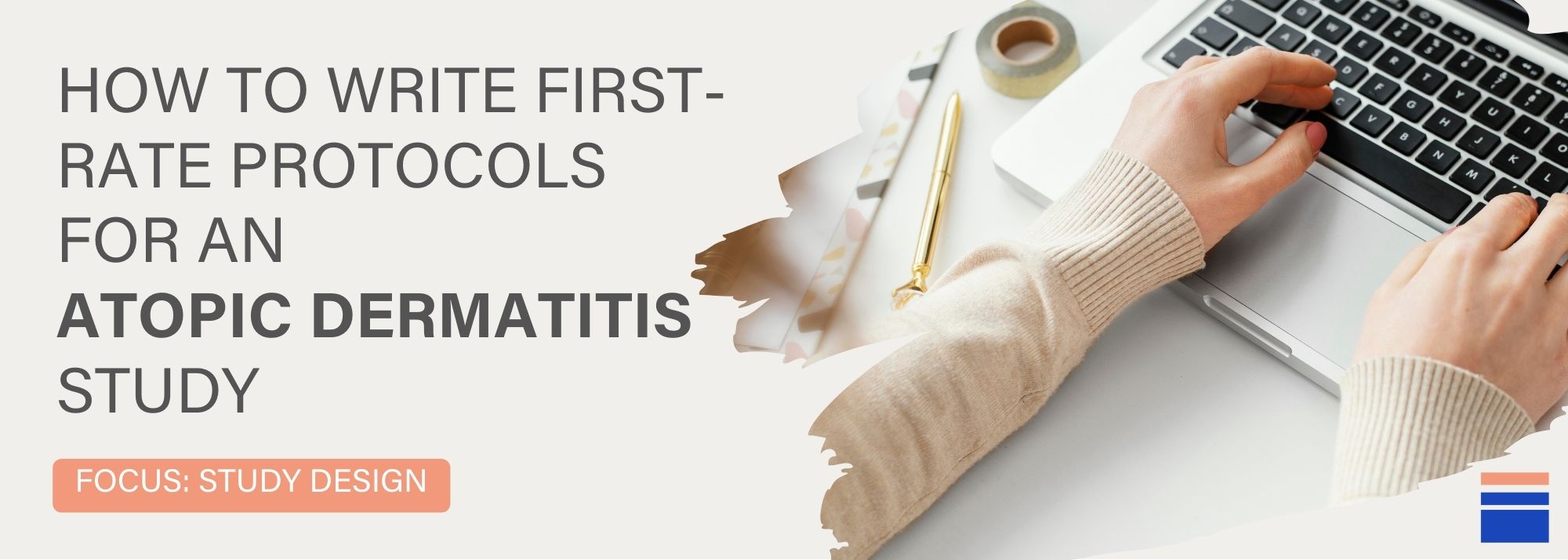How to Write First-Rate Protocols for an Atopic Dermatitis Study - Focus: STUDY DESIGN

| Table of contents |
| 1. What is atopic dermatitis? |
| 2. Insights into study design |
| 3. Screening time: 30 vs 28 days |
| 4. What is an intraindividual design? |
| 5. Conclusion |
In recent years, dermatologic therapeutics has become a subspecialty of growing interest in the CRO industry, with clinical research in the area focused on a wide range of skin indications such as acne vulgaris, psoriasis, and atopic dermatitis.
What is atopic dermatitis?
Atopic dermatitis (AD)1, also known as atopic eczema, is the most common, long-term type of inflammatory skin disease. Stemming from skin barrier dysfunction, immune alterations, or genetic or environmental factors, the condition may occur at any age but usually starts in early infancy.
Insights into study design
Before writing a protocol for AD, it is important to examine the competitive landscape for the indication under investigation and to identify the study drug’s stage of clinical development.
In a Phase 1 study, the safety and pharmacokinetics (PK) of the study drug are evaluated through intensive lab testing, electrocardiograms (ECGs), and vital sign assessments to provide full safety and PK profiles. Biomarker assessments can also offer insight on efficacy in small early phase trials.
In proof-of-concept (POC) and Phase 2 studies, the efficacy endpoint that is the most sensitive or has the greatest power to detect a difference between treatment groups should be selected. In Phase 3 studies, the protocol should be aligned as much as possible with the requirements of regulatory agencies.
Screening time: 30 vs 28 days
Thirty (30) days is the recommended screening period duration in order to allow subjects who are using medications that need to be stopped at least four weeks (28 days) prior to baseline to do so within the screening period. Many protocols tend to have a 28-day screening period; however, an extension of two days has been shown to decrease the screen failure rate. This general approach can be used for AD clinical trials involving topical or systemic agents.
What is an intraindividual design?
In AD trials with topical products, randomization can be at the level of subjects or be within subjects (i.e., intraindividual study).
An intraindividual study involves applying different study products (and/or different concentrations) to several target places on a person’s body. There are many advantages to using an intraindividual design, including a reduction in both inter-subject variability and in the number of subjects required to attain significance.
In a study that was published in November 2019 and in which Innovaderm participated, 40 adult patients had two AD lesions of identical severity randomly assigned to crisaborole or a vehicle applied twice daily for two weeks. This study involved a biopsy collection and disease severity assessments, including the pruritus numeric rating scale (NRS) of the lesions.
The results revealed significant improvement in the pruritus NRS of the lesions, demonstrating that subjects can effectively differentiate the intensity of itch in two different locations. The intraindividual design can therefore be an interesting option when seeking an early read of efficacy, such as whether a topical agent is effective for alleviating itch.While intraindividual randomized trials have many advantages, they also present several challenges and limitations, which are important to address when writing protocols. Not only should the administration of the study drug take place on site for most cases, but it also requires study personnel, some of whom may be unblinded regarding the treatment randomization. As well, the disease severity for eligibility should not be too severe since only two lesions are being treated.
Lastly, writing a first-rate protocol for a study on AD entails defining the dosage of the related drug and the duration of its treatment. In AD trials, the duration should be between four and eight weeks, which is relatively short. Indeed, AD is a highly symptomatic disease and treatment should demonstrate efficacy quickly to be commercially viable.
Conclusion
When writing an AD protocol, you must not only have a solid understanding of the indication and what you are measuring, but also keep abreast of related literature. Be it procedures for a study on AD or another skin indication, the best protocols in dermatology are often the simplest, with the goal of bridging a knowledge gap or highlighting something new in the field. Stemming from a strong collaborative effort, a first-rate protocol not only provides a roadmap for better enrollment rates and data quality, but also allows investigators to remain at the forefront of dermatology research.
About the Author
Stéphanie Légaré is a senior clinical scientist at Innovaderm with 10+ years’ experience in scientific and medical communication and translational/clinical research. Throughout her career, she has managed several investigator-initiated studies and developed training materials for pharmaceutical and life sciences companies.

***
Want to ensure your study is a great success? Contact us today to partner with our expert team of clinical trial professionals.
Newsletter
Newsletter subscription resources

